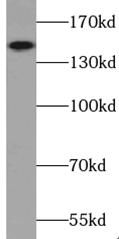Products
TRIM33 antibody
Category:
Research Area:
| Synonyms: | Ectodermin homolog antibody, FLJ32925 antibody, KIAA1113 antibody, Protein Rfg7 antibody, PTC7 antibody, RET fused gene 7 protein antibody, RFG7 antibody, TF1G antibody, TIF1 gamma antibody, TIF1G antibody, TIF1GAMMA antibody, TIFGAMMA antibody, TRIM33 antibody, tripartite motif containing 33 antibody | ||
| Catalogue No.: | FNab08981 | Reactivity: | Human |
| Host: | Rabbit | Tested Application: | ELISA, WB |
| Clonality: | polyclonal | Isotype: | IgG |
- SPECIFICATIONS
- Product Name
- TRIM33 antibody
- Catalogue No.
- FNab08981
- Size
- 100μg
- Form
- liquid
- Purification
- Immunogen affinity purified
- Purity
- ≥95% as determined by SDS-PAGE
- Clonality
- polyclonal
- Isotype
- IgG
- Storage
- PBS with 0.02% sodium azide and 50% glycerol pH 7.3, -20℃ for 12 months(Avoid repeated freeze / thaw cycles.)
Immunogen
- Immunogen
- tripartite motif-containing 33
- Alternative Names
- Ectodermin homolog antibody, FLJ32925 antibody, KIAA1113 antibody, Protein Rfg7 antibody, PTC7 antibody, RET fused gene 7 protein antibody, RFG7 antibody, TF1G antibody, TIF1 gamma antibody, TIF1G antibody, TIF1GAMMA antibody, TIFGAMMA antibody, TRIM33 antibody, tripartite motif containing 33 antibody
- UniProt ID
- Q9UPN9
- Observed MW
- 140-150 kDa
Application
- Tested Applications
- ELISA, WB
- Recommended dilution
- WB: 1:200-1:2000
Validated Images
 COLO 320 cells were subjected to SDS PAGE followed by western blot with FNab08981(TRIM33 antibody) at dilution of 1:500
COLO 320 cells were subjected to SDS PAGE followed by western blot with FNab08981(TRIM33 antibody) at dilution of 1:500
- Background
- Acts as an E3 ubiquitin-protein ligase. Promotes SMAD4 ubiquitination, nuclear exclusion and degradation via the ubiquitin proteasome pathway. According to PubMed:16751102, does not promote a decrease in the level of endogenous SMAD4. May act as a transcriptional repressor. Inhibits the transcriptional response to TGF-beta/BMP signaling cascade. Plays a role in the control of cell proliferation. Its association with SMAD2 and SMAD3 stimulates erythroid differentiation of hematopoietic stem/progenitor(By similarity). Monoubiquitinates SMAD4 and acts as an inhibitor of SMAD4-dependent TGF-beta/BMP signaling cascade(Monoubiquitination of SMAD4 hampers its ability to form a stable complex with activated SMAD2/3 resulting in inhibition of TGF-beta/BMP signaling cascade).



